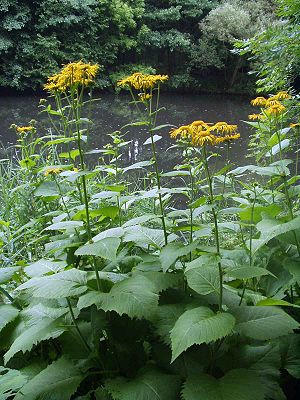Great Telekie
| Great Telekie | ||||||||||||
|---|---|---|---|---|---|---|---|---|---|---|---|---|

Great Telekie ( Telekia speciosa ) |
||||||||||||
| Systematics | ||||||||||||
|
||||||||||||
| Scientific name | ||||||||||||
| Telekia speciosa | ||||||||||||
| ( Schreb. ) Baumg. |
The Great Telekie ( Telekia speciosa ), also Scheinalant called, is a species of the family of the daisy family (Asteraceae).
features
The Greater Telekie is a perennial, herbaceous plant that reaches heights of growth of about 100 to 150 (200) centimeters. The plant forms a rhizome . The basal leaves are long stalked and about 30 centimeters wide. Your blade is broadly ovate and has a heart-shaped base. The base of the upper stem leaves is truncated in a wedge shape. They are seated at most half a stalk.
Usually there are 2 to 8 flower heads. These have a diameter of 6 to 8 centimeters. The bracts are egg-shaped, the outer ones have a bent-back, leaf-shaped tip. The ray-florets are deep golden yellow. The tubular flowers are brownish yellow.
The flowering period extends from June to August.
The number of chromosomes is 2n = 20.
The great telekie is similar to the common elephant ( Inula helenium ), but differs from it in the underside of its leaves: The telekie's somewhat heart-shaped leaves are also green from below, while the more elongated leaves of the common elephant have woolly hair on the underside are.
Occurrence
The Greater Telekie occurs in south-east Europe, northern Turkey and in the Caucasus in the edges of mountain forests, on the banks of streams and in tall herbaceous areas at altitudes of 300 to 2400 meters. In Southeastern Europe it is a species of Petasiti-Telekietum from the Aegopodion association, but also occurs in societies of the Atropion association. The species was naturalized in Western and Central Europe. It is a neophyte in Belgium, the Czech Republic, Germany, Austria and Estonia .
use
The large telekie is widely used as an ornamental plant for pond banks, shrubbery borders and parks, and as a cut plant. It has been in culture since 1739 at the latest.
See also
supporting documents
- Eckehart J. Jäger, Friedrich Ebel, Peter Hanelt, Gerd K. Müller (eds.): Excursion flora from Germany . Founded by Werner Rothmaler. tape 5 : Herbaceous ornamental and useful plants . Springer, Spektrum Akademischer Verlag, Berlin / Heidelberg 2008, ISBN 978-3-8274-0918-8 .
Individual evidence
- ^ TG Tutin, VH Heywood, NA Burges, DM Moore, DH Valentine, SM Walters, DA Webb (eds.): Flora Europaea . Volume 4: Plantaginaceae to Compositae (and Rubiaceae) . Cambridge University Press, Cambridge 1976, ISBN 0-521-08717-1 , pp. 138 (English, limited preview in Google Book search).
- ↑ Große Telekie (Scheinalant) - Determination & Use , www. Pflanzen-vielfalt.net , last accessed on September 26, 2019.
- ↑ Werner Greuter (2006+): Compositae (pro parte majore). - In: W. Greuter & E. von Raab-Straube (eds.): Compositae. Euro + Med Plantbase - the information resource for Euro-Mediterranean plant diversity. Datasheet Telekia In: Euro + Med Plantbase - the information resource for Euro-Mediterranean plant diversity.
- ^ Erich Oberdorfer : Plant-sociological excursion flora for Germany and neighboring areas . With the collaboration of Angelika Schwabe and Theo Müller. 8th, heavily revised and expanded edition. Eugen Ulmer, Stuttgart (Hohenheim) 2001, ISBN 3-8001-3131-5 , pp. 923-924 .
- ↑ Telekia in the Germplasm Resources Information Network (GRIN), USDA , ARS , National Genetic Resources Program. National Germplasm Resources Laboratory, Beltsville, Maryland. Retrieved March 7, 2018.
Web links
- Telekia speciosa (Schreb.) Baumg., Ordinary Telekie. In: FloraWeb.de.
- Great Telekie . In: BiolFlor, the database of biological-ecological characteristics of the flora of Germany.
- Profile and distribution map for Bavaria . In: Botanical Information Hub of Bavaria .
- Telekia speciosa (Schreb.) Baumg. In: Info Flora , the national data and information center for Swiss flora . Retrieved April 23, 2016.
- Thomas Meyer: Telekie data sheet with identification key and photos at Flora-de: Flora von Deutschland (old name of the website: Flowers in Swabia )
